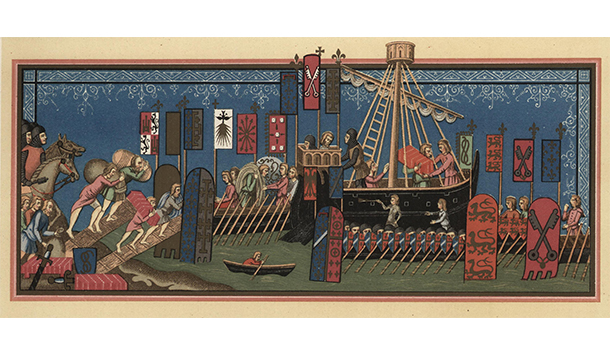The Christian Crusades of the Middle Ages are today deployed for a wide range of political and rhetorical purposes—to make claims about the Church’s betrayal of Christ’s teaching, the evils of European imperialism, or the inextricable link between intolerant religion and ghastly violence. Any or all of those claims might be justified. One problem, though, distorts virtually all modern discussions of those seminal events. Contrary to common assumptions, the Crusades were neither a miserable failure nor an exercise in futility. Despite some defeats, their victories were extensive, enduring, and critical.
Such a claim is neither an exercise in casuistry, nor a deliberate paradox. Yes, if we consider the European effort to retake the Holy Land and the Holy Places, then that assuredly failed. From the launching of the First Crusade in 1095 until the mid-13th century, Latin Catholic forces ruled a network of cities and states in the Levant, extending across Palestine, Syria, and Lebanon. Gradually, these were overwhelmed. Antioch fell in 1268, and the Muslim conquest of Acre in 1291 effectively ended Crusader power in the region. Despite later calls for renewed Crusades at least into the 17th century, that particular theater of warfare was closed by a decisive Muslim victory.
But that theater was only one of many. In exactly the same years that the Latins were fighting to retain their toeholds in Palestine, their friends and relatives were struggling against other enemies of the Faith, in Iberia, southern Italy and Sicily, and the Baltic lands, and in most cases, they were winning powerfully and repeatedly.
So successful were they, in fact, that the regimes they established came to seem natural and inevitable, and not something that people would ever have fought over. How absurd to suggest that Christians need go to war to secure their hold over (say), Portugal! As any fool knows, Portugal is an integral part of Christian, Catholic, Latin Europe, and it must always have been so. That fact is just as eternal and inevitable as the converse reality that Syria was always destined to be part of Dar al-Islam. Based on such retroactive certainty, we are quite confident that Christian efforts in Palestine were doomed just as thoroughly as were Muslim attempts to maintain their grasp on the Iberian peninsula.
Such certainties were not nearly as clear or definite at the time.
Instead of concentrating tightly on the Levant, shift the focus to consider the wider world. Exactly in 1147, when the Latin Second Crusade reached Palestine, Western Crusaders were seizing Lisbon, and laying the foundation of Christian Portugal. In the 13th century, when the Latins in Syria were enjoying the short-lived fruits of the Third Crusade, their Spanish counterparts were winning such decisive victories as Las Navas de Tolosa (1212). In the following decades, Islamic territories in Spain were reduced to rump status, with only the Kingdom of Granada left as an active state. That was finally crushed in 1492. Christians were just as successful in Sicily, which was wholly occupied in 1091.
It might be objected here that these Southern European campaigns cannot be included in the Crusades proper because they originated before that great outpouring of religious zeal that Pope Urban II unleashed in 1095. At every point, though, these other movements used precisely the same rhetoric and symbolism as those actions in Palestine, the same idea of serving the Church by taking the cross. Some historians see Urban’s move against Palestine as being in direct continuity with the victories in Sicily.
So common did the Crusaders’ language become that it was widely applied to wars against Christian heretics, and even against political rivals who opposed papal causes. Technically, even warriors who fought for the English king against his baronial enemies in 1216-17 were entitled to wear the cross, and to fulfill Crusader vows. Beyond doubt, any and all warriors fighting to reconquer Christian lands from Islam were considered Crusaders of the highest order.
Often forgotten in discussions of the Crusading movement are the “Northern Crusades,” in which mainly Germanic Catholics conquered and settled lands held by Baltic pagans. Again, the chronology neatly coincides with the efforts in the Mediterranean, and the most intense warfare occurred in the century after 1147.
Around 1380, Geoffrey Chaucer supplied a curriculum vitae for the Knight in his Canterbury Tales. Although that Knight had not visited Palestine, he held battle honors from all the Crusading battlefronts of his day—in Egypt and North Africa; in southern Spain; in Latvia, Prussia, and Russia. He would have been startled to find that later historians arbitrarily carve out only a small portion of these wars as “real” Crusades, and conveniently forgot the rest.
Would it actually hurt to admit that the Crusades were, generally, an enormous success?

Leave a Reply